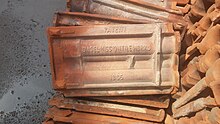Mangalore tiles
Mangalore tile
Old Manglore tiles, from an old site in Karachi, Pakistan.
Contents
Etymology
These tiles are native to Mangalore, a city in the former South Canara district on the western coast of India. Hence they were named Mangalore tiles by the tile factory manufacturers.[1]History
Tile Factory in Feroke, India
Several other tile factories were established in the years that followed. In 1868, the Albuquerque tile factory producing these tiles was started by Mr.Pascal Albuquerque at Panemangalore in South Canara.[4] These were the only tiles to be recommended for Government buildings in India during the British regime.[3] The Chhatrapati Shivaji Terminus, a World Heritage Site is also topped with these tiles due to their excellent quality and were preferred over Bombay tiles by the structure's architect Frederick William Stevens.[6]
Mangalore tile manufactured by J. H. Morgan & Sons (Mangalore)
The prominent tile factories in Mangalore of the bygone era were
1) The Common Wealth Trust Ltd (Established by Basel Mission in 1860 [10]) - This is supposed to be the first tile factory in Mangalore and thereby India.
2) A Albuquerque and Sons (Established in 1868).
3) Alvares Tile factory (Established by Simon Alvares in 1878)
4) Hammer Tiles (Established by Mahalakshmi traders in 1889).
5) Hamidiah Tile works (Established by Adhyaksha H. Coragappa(Founder of Kudroli Shree Gokarnanatheshwara Temple Mangalore [11]) and C.Abdurahiman in 1905)
6) King George Tiles (Established in 1905).
7) JH Morgan and son.
8) Rego and sons.
9) Pioneer Tiles.
10) BK Tiles.
The Calicut Tile Co. (CTC) was the first fully mechanised roofing tile manufacturer in India. It was started in the year 1878. Besides roofing tiles, CTC also manufactures ceiling tiles, hourdees, hollow blocks, paver tiles, decorative garden tiles and terracotta products. The company is currently fully operational. The products CTC at Ferok are known and sold under the brand name QUEEN. They have another factory in the state of Karnataka. The products are known under the brand name KING.
In 2007, the industry suffered a loss with about 10 tile factories shutting down due to scarcity of raw materials like clay, and as factories struggled to find skilled and cooperative workers.[7]
Quality and Usage
These tiles define Mangalore's skyline and characterize its urban setting
Since these clay tiles are molded under extreme heat, they are resistant to damage or destruction from fire.
These red colored clay tiles, unique in shape and size, are quite famous and are exported to all the corners of world. They are unique and are made and available in different shapes and sizes depending on the users' need. Clay tiles are often white, yellow, orange or brown in color. However, they can be colored or styled according to one’s preference by spraying enamel over the tile once it has been colored before baking it in the kiln.
These tiles are not only eco-friendly but also cheap, durable and costs only one third of that of cement. Some of the buildings which are over 100 years old still have tile roofing.
Clay tiles are most apt for roofing solutions in coastal areas, and in regions that experience heavy rainfall. Clay tiles for a sloping roof offer excellent water proofing in regions where it rains quite often. It is corrosion resistant, and has superior longevity compared to other materials. The Mangalore tiles are generally placed inclined at forty five degrees. The tiles get their robust red colour due to the high proportion of iron compound found in the laterite clay.[12] A tile weighs about 2 kilograms (4.4 lb) to 3 kilograms (6.6 lb).[13] These kinds of tiles are most popularly used in Canara, Goa, Kerala, and the Konkan.
Preparation
First, enough clay is collected, placed in a mold and is precisely cut to measurement. Then, the molded piece of clay with required length and thickness (or shape) is placed on another machine which puts the factory logo and shapes it into a tile. Then, any extra clay is removed by hand and sent or carried for firing and later glazing. It is heated in a kiln, and the density of the clay tile is determined by the length of time and temperature at which it is heated.Clay tiles are often white, yellow, orange or brown in color. However, they can be colored or styled according to one’s preference by spraying enamel over the tile once it has been colored before baking it in the kiln. The extreme heat of the kiln permanently bonds the color and enamel to the tile, ensuring the color does not peel or fade away over time.
It was interesting, to say the least to see how both men and women worked cooperatively to produce the final product. Once fired and glazed, it is ready, and is stored for transport/shipping.[13]





No comments:
Post a Comment